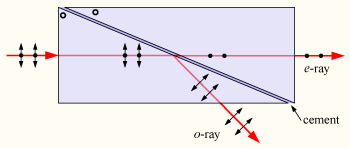.
Glan-Thompson prism

A Glan-Thompson prism deflects the p-polarized ordinary ray whilst transmitting the s-polarized extraordinary ray. The two halves of the prism are joined with optical cement, and the crystal axes are perpendicular to the plane of the diagram.
A Glan-Thompson prism is a type of polarizing prism similar to a Nicol prism. It consists of two right-angled calcite prisms that are cemented together by their long faces. The optical axes of the calcite crystals are parallel and aligned perpendicular to the plane of reflection. Birefringence splits light entering the prism into two rays, experiencing different refractive indices; the p-polarized o-ray is totally internally reflected from the calcite-cement interface, leaving the s-polarized e-ray to be transmitted. The prism can therefore be used as a polarizing beam splitter. Traditionally Canada balsam was used as the cement in assembling these prisms.
Compared to the similar Glan-Foucault prism, the Glan-Thompson has a wider acceptance angle, but a much lower limit of maximum irradiance (due to optical damage limitations of the cement layer).
See also
* Glan-laser prism
Retrieved from "http://en.wikipedia.org/"
All text is available under the terms of the GNU Free Documentation License

